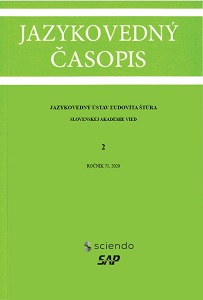Celkom iste sa príde na to , že niektoré slová sa opakujú doslovne : Horeckého hypersyntax
It will certainly be found that some words are literally repeated: Horecký’s hypersyntax.
Author(s): Dan FaltýnekSubject(s): Theoretical Linguistics, Syntax, Lexis
Published by: Jazykovedný ústav Ľudovíta Štúra Slovenskej akadémie vied
Keywords: textual cohesion; textual isotopy; langue parole opposition; hapax legomena; hapax legomena n-gram analysis; authorship attribution;
Summary/Abstract: The article reflects the linguistic work of Ján Horecký in connection with hyper syntax and text linguistics. In his work Základy jazykovedy (Outline of linguistics) Ján Horecký remarks (1974, p. 90) that one of the principles of text construction is the literal repetition of certain words. We discuss this Horecký’s assumption and describe its consequences for the langue parole opposition and the concepts of textual isotopy and textual cohesion. The main task of the article is to examine Horeský’s assumption. For these purposes, we present an authorship attribution analysis of literary works by two Slovak authors: Svetozár Hurban Vajanský and Martin Kukučín. We focus on low-frequency lexicon, i.e. hapax legomena, which are supposed to be independent of the authorial style (e.g. Binongo, 2003) and should reflect random circumstances of communication (de Saussure, 1996, p. 50; Bloomfield, 1933, p. 170). This means that if the structure of the text were to be affected by the repetition of certain words, the low frequency layer of the lexicon should contain evidence of this repetition with a low degree of dependence on the content and style of the literary work (Baayen, 1996). // The analysis and its presentation is based on separate processing of hapax legomena and their n-grams, cosine dissimilarity and multidimensional scaling (Torgerson, 1952). Contrary to the general notion of the text structure, we conclude that the authorial texts are based on the repetition of certain word forms and word forms combinations (by n-gram analysis), even in the level of low-frequency words.
Journal: Jazykovedný časopis
- Issue Year: 71/2020
- Issue No: 2
- Page Range: 185-196
- Page Count: 12
- Language: Czech

